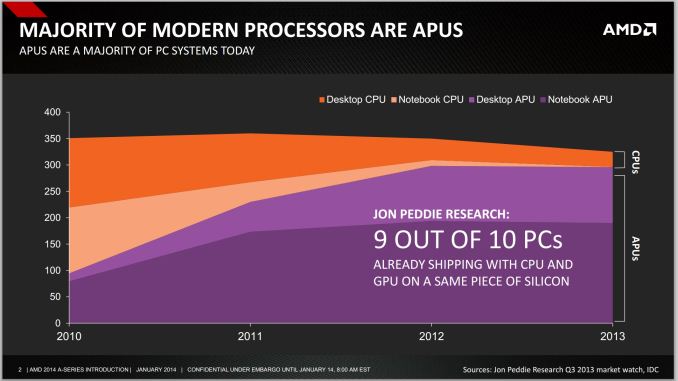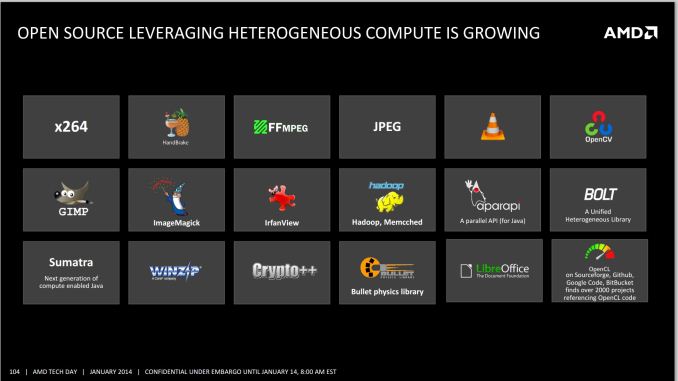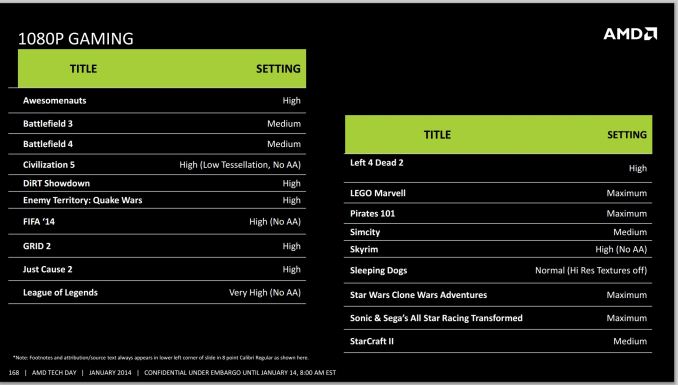AMD Kaveri Review: A8-7600 and A10-7850K Tested
by Ian Cutress & Rahul Garg on January 14, 2014 8:00 AM ESTKaveri: Aiming for 1080p30 and Compute
The numerical differences between Kaveri and Richland are easy enough to rattle off – later in the review we will be discussing these in depth – but at a high level AMD is aiming for a middle ground between the desktop model (CPU + discrete graphics) and Apple’s Mac Pro dream (offloading compute onto different discrete graphics cards) by doing the dream on a single processor. At AMD’s Kaveri tech day the following graph was thrown in front of journalists worldwide:
With Intel now on board, processor graphics is a big deal. You can argue whether or not AMD should continue to use the acronym APU instead of SoC, but the fact remains that it's tough to buy a CPU without an integrated GPU.
In the absence of vertical integration, software optimization always trails hardware availability. If you look at 2011 as the crossover year when APUs/SoCs took over the market, it's not much of a surprise that we haven't seen aggressive moves by software developers to truly leverage GPU compute. Part of the problem has been programming model, which AMD hopes to address with Kaveri and HSA. Kaveri enables a full heterogeneous unified memory architecture (hUMA), such that the integrated graphics topology can access the full breadth of memory that the CPU can, putting a 32GB enabled compute device into the hands of developers.
One of the complexities of compute is also time: getting the CPU and GPU to communicate to each other without HSA and hUMA requires an amount of overhead that is not trivial. For compute, this comes in the form of allowing the CPU and GPU to work on the same data set at the same time, effectively opening up all the compute to the same task without asynchronous calls to memory copies and expensive memory checks for coherency.
The issue AMD has with their HSA ecosystem is the need for developers to jump on board. The analogy oft cited is that on Day 1, iOS had very few apps, yet today has millions. Perhaps a small equivocation fallacy comes in here – Apple is able to manage their OS and system in its entirety, whereas AMD has to compete in the same space as non-HSA enabled products and lacks the control. Nevertheless, AMD is attempting to integrate programming tools for HSA (and OpenCL 2.0) as seamlessly as possible to all modern platforms via a HSA Instruction Layer (HSAIL). The goal is for programming languages like Java, C++ and C++ AMP, as well as common acceleration API libraries and toolkits to provide these features at little or no coding cost. This is something our resident compute guru Rahul will be looking at in further detail later on in the review.
On the gaming side, 30 FPS has been a goal for AMD’s integrated graphics solutions for a couple of generations now.
Arguably we could say that any game should be able to do 30 FPS if we turn down the settings far enough, but AMD has put at least one restriction on that: resolution. 1080p is a lofty goal to hold at 30 FPS with some of the more challenging titles of today. In our testing in this review, it was clear that users had a choice – start with a high resolution and turn the settings down, or keep the settings on medium-high and adjust the resolution. Games like BF4 and Crysis 3 are going to tax any graphics card, especially when additional DirectX 11 features come in to play (ambient occlusion, depth of field, global illumination, and bilateral filtering are some that AMD mention).













380 Comments
View All Comments
just4U - Wednesday, January 15, 2014 - link
Well power wise the $120 cpu would likely be the route to go.. You sort of missed the curve really.. since the leaps in performance on the C2D in 2007 (09 for AMDs PIIs) really made the old X2s obsolete... so yeah in that sense excellent upgrade. Video wise? Hummm.. I want to say it's going to be better.. but not sure by how much.tipoo - Tuesday, January 14, 2014 - link
What's up with the Iris Pros bottom score in the Bioshock Infinite minimum FPS test, where it did well in the average FPS? Does it have framerate drops?Nova17745 - Tuesday, January 14, 2014 - link
So the minor improvement of integrated graphics makes this all ok? I'll keep my i7-4770kjust4U - Wednesday, January 15, 2014 - link
Yes.. and I'll keep my 2700K rather than go for your i7-4700K as I think it's within a few percentage points of yours.. but can maintain higher over clocks (if I wanted to oc) due to temperature issues surrounding the temperatures issues of ivyb/haswell but if I wanted to build a lite streaming box for the TV room (no games..) and not spend a lot this would be a excellent option.jrs77 - Tuesday, January 14, 2014 - link
I couldn't care less about the iGPU tbqh, as the majority of the professional software I'm using doesn't make any use of it, but relies purely on the CPU.I'd like to see more reallife benchmarks, as they would show that Kaveri isn't at all too be recommended, if you're working with your PC.
Image editing (Adobe Ps), image rendering (Cycles, LuxRender, VRay), office (MS, OOP, Libre), music-editing (FL Studio, Reason, etc). All this sofftware is heavily used by alot of homeusers, and all of this software doesn't make any use of GPGPU or OpenCL basically.
Kaveri is good foor a cheap HTPC, but so is a cheap intel i3.
Everyone who is building a PC for playing games would never consider doing it without a dedicated GPU, so why should we care about these gaming-benchmarks on the iGPU?
I was hoping that AMD improves the CPU-part, but seeing that my old i5-3450 is still crushing the A10-7850k in CPU-performance is actually a rather sad story for AMD. In Cinebench R15 it's allmost 100 points difference between the two, or 25% if you like, and both chips cost the same, while the intel i5 is much better in energy-efficiency.
YuLeven - Tuesday, January 14, 2014 - link
You Core i5 crushes A10-7800K's performance CPU wise costing the same, a cheap Athlon or Pentium CPU paired with a HD7770GE wipes the floor with A10-7800K's gaming performance, also costing the same (just checked the prices at newegg).It's all about picking it right. If you go with this APU, you are stuck in the middle. So-so CPU performance, so-so 720p gaming.
codedivine - Tuesday, January 14, 2014 - link
Blender Cycles is getting OpenCL acceleration. I believe Apple is helping out with that. And LibreOffice folks also showed OpenCL acceleration.jrs77 - Tuesday, January 14, 2014 - link
Blender Cycles getting some OpenCL love is nice, but it's not actually the most relevant renderer. I'm either using V-Ray or LuxRender most of the time, and the V-Ray 2.0 RT is a joke, as it can't render scenes using the chosen textures, but only renders standard-materials, just like any other GPU-based renderer currently.And I don't think that the intel iGPU is much slower for GPGPU, especially knowing that it's faster in video-encoding than the AMD iGPU, so the problem oof the bad single-threaded performance still speaks against AMD.
The smaller 45W Kaveri-chips are much more interesting imho, especially for HTPCs, as they can be cooled passively and will be dirt-cheap at $50 a pop.
mikato - Wednesday, January 15, 2014 - link
Well come on you're the one that mentioned it to begin with, and LibreOffice too. I imagine these will show substantial improvements.chizow - Tuesday, January 14, 2014 - link
Shocking that Kaveri is slower than Richland in many CPU-related tasks, it's as if AMD is pulling a Bulldozer all over again. Wasn't Steamroller supposed to redeem the whole "Construction" line of CPUs? It's no wonder they decided to cancel FX for the desktop, it'd be Bulldozer all over again.